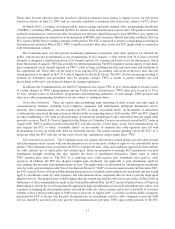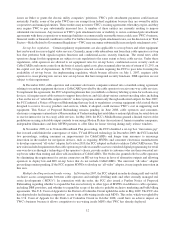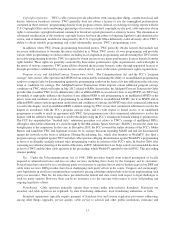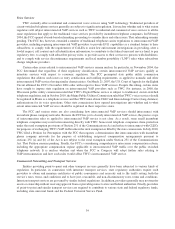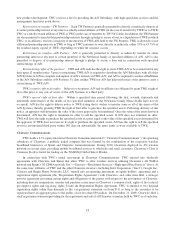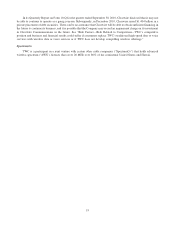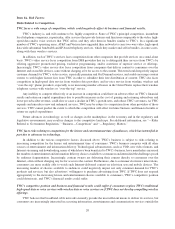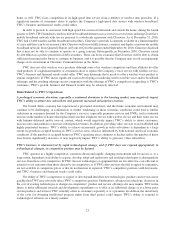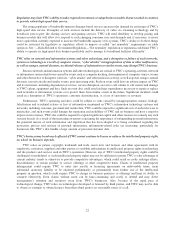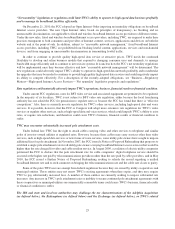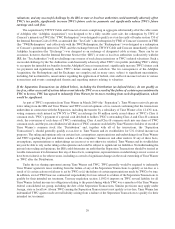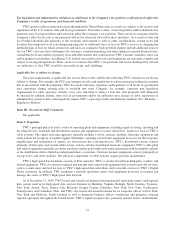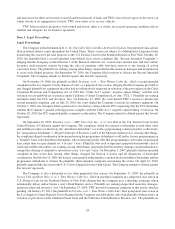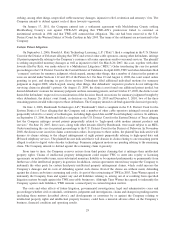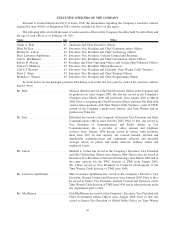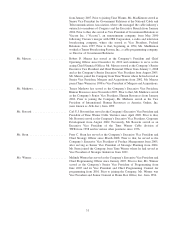Time Warner Cable 2010 Annual Report Download - page 33
Download and view the complete annual report
Please find page 33 of the 2010 Time Warner Cable annual report below. You can navigate through the pages in the report by either clicking on the pages listed below, or by using the keyword search tool below to find specific information within the annual report.home as well. TWC faces competition in its high-speed data service from a number of wireless data providers. If a
significant number of consumers chose to replace the Company’s high-speed data service with wireless broadband,
TWC’s business and financial results could suffer.
In order to provide its customers with high-speed data services both inside and outside the home, during the fourth
quarter of 2009, TWC launched a wireless mobile broadband Internet access service in several cities utilizing Clearwire’s
mobile broadband network with service pursuant to a wholesale agreement with Clearwire. As of December 31, 2010,
TWC had 13,000 wireless mobile broadband subscribers. Clearwire’s network is currently available in a limited number
of cities and there can be no assurance that Clearwire will successfully finance, construct and deploy a nationwide mobile
broadband network. In its Quarterly Report on Form 10-Q for the quarter ended September 30, 2010, Clearwire disclosed
that it may not be able to continue to operate as a going concern. Subsequently, in December 2010, Clearwire raised
$1.404 billion in a private placement of debt securities. There can be no assurance that Clearwire will be able to obtain
sufficient financing in the future to continue its business, and it is possible that the Company may record an impairment
charge on its investment in Clearwire Communications in the future.
TWC does not offer wireless voice products although some of its wireline competitors and their affiliates do offer
such products. If a significant number of consumers chose to replace the Company’s voice service with wireless service,
TWC’s business and financial results could suffer. TWC may determine that it needs to offer a wireless voice product to
remain competitive. If TWC incurs significant costs in developing or marketing wireless mobile voice and/or broadband
offerings, and the resulting offerings are not competitive with the offerings of TWC’s competitors or appealing to TWC’s
customers, TWC’s growth, business and financial results may be adversely affected.
Risks Related to TWC’s Operations
A prolonged economic downturn, especially a continued downturn in the housing market, may negatively impact
TWC’s ability to attract new subscribers and generate increased subscription revenues.
The United States economy has experienced a protracted slowdown, and the future economic environment may
continue to be challenging. A continuation or further weakening of these economic conditions could lead to further
reductions in consumer demand for the Company’s services, especially premium services and DVRs, and a continued
increase in the number of homes that replace their wireline telephone service with wireless service and their video service
with Internet-delivered and/or over-air content, which would negatively impact TWC’s ability to attract customers,
increase rates and maintain or increase subscription revenues. In addition, providing video services is an established and
highly penetrated business. TWC’s ability to achieve incremental growth in video subscribers is dependent to a large
extent on growth in occupied housing in TWC’s service areas, which is influenced by both national and local economic
conditions. If the number of occupied homes in TWC’s operating areas continues to decline and/or the number of home
foreclosures significantly increases, it may negatively impact TWC’s ability to gain new video subscribers.
TWC’s business is characterized by rapid technological change, and if TWC does not respond appropriately to
technological changes, its competitive position may be harmed.
TWC operates in a highly competitive, consumer-driven and rapidly changing environment and its success is, to a
large extent, dependent on its ability to acquire, develop, adopt and exploit new and existing technologies to distinguish its
services from those of its competitors. If TWC chooses technologies or equipment that are less effective, cost-efficient or
attractive to its customers than those chosen by its competitors, or if TWC offers services that fail to appeal to consumers,
are not available at competitive prices or that do not function as expected, TWC’s competitive position could deteriorate,
and TWC’s business and financial results could suffer.
The ability of TWC’s competitors to acquire or develop and introduce new technologies, products and services more
quickly than TWC may adversely affect TWC’s competitive position. Furthermore, advances in technology, decreases in
the cost of existing technologies or changes in competitors’ product and service offerings also may require TWC in the
future to make additional research and development expenditures or to offer at no additional charge or at a lower price
certain products and services TWC currently offers to customers separately or at a premium. In addition, the uncertainty
of the costs for obtaining intellectual property rights from third parties could impact TWC’s ability to respond to
technological advances in a timely manner.
21


